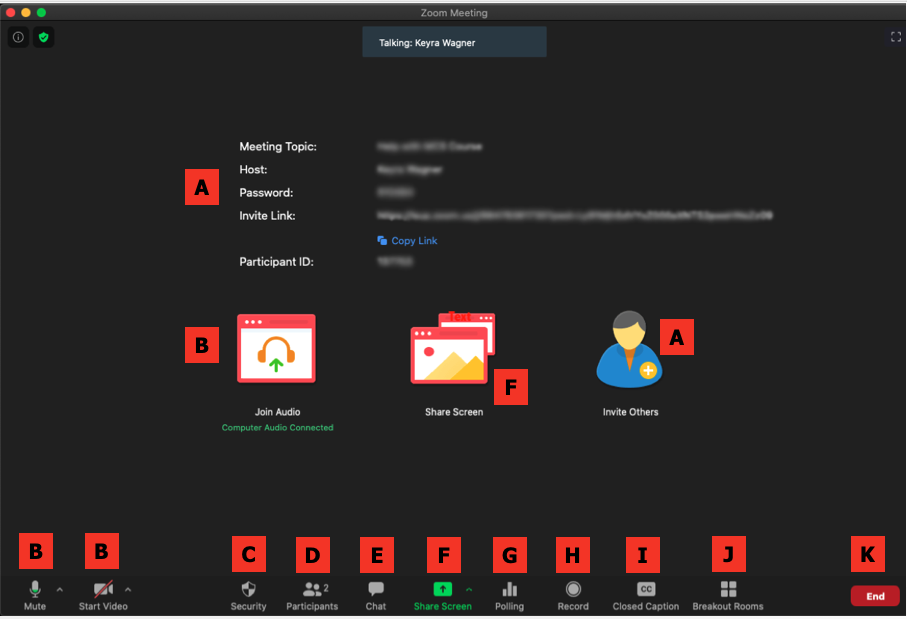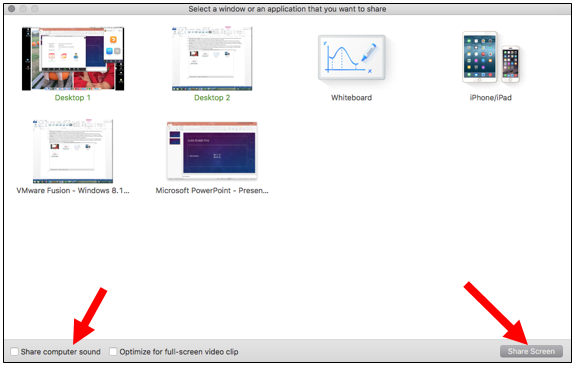Once starting, or joining, a meeting you will be presented with several options for communicating and sharing content with other participants. If the bar of icons (found at the bottom of the image below) is not showing, move your mouse towards the bottom of the monitor. This will cause the menu bar to appear.
This screenshot below represents a meeting that started without a video.
This screenshot below represents a meeting that started without a video.

A. Inviting others to the meeting: There are several ways to invite other people to join the meeting. All items marked with A will provide you the means to generate an invitation or you can simply copy the URL that is unique to your meeting.
B. Audio and Video: This is where you can adjust your computer settings to allow/disallow audio and video connections. You can join audio through your computer microphone and/or phone line. You also have the ability to toggle your webcam to be on or off during your meeting. Also, clicking the up arrow next to start video gives you the options to select a Virtual Background.
C. Security: This is where you can lock the meeting, enable a waiting room, and manage what your participants are allowed to do. We recommend enabling the waiting room.
D. Participants: This icon will allow you to see all active participants in the meeting. If you are the host of the meeting, you will see some additional icons next to their name, for example, unmuting their microphone and renaming their display name.
E. Chat: Send messages and/or files to the entire participant list or individuals. If you are unable to sent files via the Chatroom, make sure the setting is enabled in your account. Review the Recommended Zoom Settings article for more details.
F. Sharing Screen: When you are ready to share materials with the participants, you will select the “share screen” option. All available windows and/or applications will show. You have the option to share your entire desktop, a specific program, a whiteboard space, or even an app found on your iPhone/iPad. Select the window that you wish to display and then share screen. If the material you are sharing contains sound, make sure to select “share computer audio” found on the bottom left hand part of the window before selecting share screen.


G. Polling: The polling feature for meetings allows you to create single choice or multiple choice polling questions for your meetings. You will be able to launch the poll during your meeting and gather the responses from you attendees. You also have the ability to download a report of polling after the meeting. If you do not see a polling option on your toolbar, you may need to enable it in your account settings. Review the Recommended Zoom Default Settings article for more details. Also, here's a help article on Polling on the Zoom website.
H. Record: Hosts have the ability to record meetings for future review. By default, the host has the ability to record a meeting which can be saved locally on to the computer (usually saves by default to your Documents folder) or sent to the Zoom Cloud. Recordings sent to the Zoom Cloud remain there for 7 days. Recordings are also sent to your VidGrid account as a backup. Review the articles below to learn about different ways to manage your Zoom recordings.
I. Closed Caption: Closed Captioning in a Zoom meeting allows you (the host) to assign another meeting attendee to add closed captioning in a meeting. Captioning must be typed directly in Zoom or a 3rd party service must be used. We do not have a third party service for captioning integrated into our license with Zoom.
J. Breakout Rooms: Breakout rooms allow you to split your Zoom meeting in up to 50 separate sessions. Participants in the room will be split off from the main Zoom meeting into smaller meeting rooms which can be used for collaboration and smaller discussions. If you do not see the Breakout room option in your meeting, you may need to enable it in your account settings. Review the Recommended Zoom Default Settings article for more details.
K. End: The End button allows you as the host to end the meeting for all participants. Or if you're a participant in the meeting, clicking End, will log you out but the meeting will continue without you.
